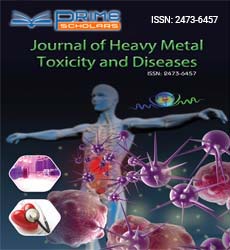Perspective - (2023) Volume 8, Issue 1
Heavy Metals Generally Arise in Nature and are Important to Life
Tawfik A. Saleh*
Department of Chemistry, University of Tokat Gaziosmanpasa, Turkey
*Correspondence:
Tawfik A. Saleh,
Department of Chemistry, University of Tokat Gaziosmanpasa,
Turkey,
Email:
Received: 31-Jan-2023, Manuscript No. IPJHMCT-23-15858;
Editor assigned: 02-Feb-2023, Pre QC No. IPJHMCT-23-15858 (PQ);
Reviewed: 16-Feb-2023, QC No. IPJHMCT-23-15858;
Revised: 21-Feb-2023, Manuscript No. IPJHMCT-23-15858 (R);
Published:
28-Feb-2023, DOI: 10.21767/2473-6457.23.8.010
Introduction
Soil contamination, soil contamination, or land contamination
as part of soil degradation is caused by the presence of xenobiotic
(man-made) chemicals or other changes in the natural soil
environment. This is usually caused by industrial activity, pesticides,
or improper waste disposal. The chemicals most commonly
involved are petroleum hydrocarbons, polynuclear aromatic
hydrocarbons (such as naphthalene and benzo (a) pyrene), solvents,
pesticides, lead, and other heavy metals. Pollution correlates
with the degree of industrialization and the intensity
of chemicals. Concerns about soil contamination arise primarily
from health hazards, direct contact with contaminated soil,
fumes from pollutants, or cross-contamination of water supplies
in and below the soil.
Description
Mapping and consequent remediation of contaminated soil sites
is a time-consuming and expensive task requiring expertise in geology,
hydrology, chemistry, computer modeling, and GIS in environmental
contamination, and an understanding of the history
of industrial chemistry. Is required The extent of contaminated
land is best known in North America and Western Europe, and
many countries in these regions have legal frameworks in place
to recognize and manage this environmental problem. Developing
countries are generally less regulated, but some countries
are highly automated. Heavy metals and other soil contaminants
adversely affect soil microbial activity, species composition, and
abundance, threatening soil functions such as carbon and nitrogen
biochemical cycling. However, soil contaminants can become
less bioavailable over time, allowing microbes and ecosystems
to adapt to changing conditions. Soil properties such as pH, ororganic
matter content, and texture are of great importance and
modify the mobility, bioavailability, and toxicity of contaminants
in contaminated soils. The same amount of contaminant can be
toxic in one soil but completely harmless in another. This highlights
the need for soil-specific risk assessment and countermeasures.
Most heavy metals cause environmental and air pollution
and can be deadly to humans. Heavy metals can be highly toxic
when mixed with various ecosystem elements such as water, soil
and air. Humans and other organisms can be exposed to them
through the food chain. The sources of heavy metals in the environment
can be both natural/geological/lithogenic and anthropogenic.
The global trend of industrialization and urbanization on
earth is increasing the anthropogenic heavy metal content in the
environment. These metals (heavy metals) are released during
the mining and extraction of various elements from their respective
ores. Effluents, such as industrial and domestic wastewater,
add heavy metals to the environment. The use of chemical fertilizers
and the burning of fossil fuels also contribute to the manmade
contribution of heavy metals to the environment.
Conclusion
Phosphate fertilizers are of particular importance in the heavy
metal content of commercial chemical fertilizers. Generally,
phosphate fertilizers are made from phosphate rock (PR) by
acidification. Acidification of simple superphosphate (SSP) uses
sulfuric acid and acidification of triple superphosphate (TSP)
uses phosphoric acid. Commercial inorganic fertilizers, especially
phosphate fertilizers, may contribute to the global transportation
of heavy metals. Heavy metals added to agricultural soils by inorganic
fertilizers can leach and contaminate groundwater. Two
major pathways by which toxic heavy metals enter the human
body from phosphate fertilizers.
Citation: Saleh T (2023) Heavy Metals Generally Arise in Nature and are Important to Life. J Heavy Met Toxicity Dis. 8:010.
Copyright: © 2023 Saleh T. This is an open-access article distributed under the terms of the Creative Commons Attribution License,
which permits unrestricted use, distribution, and reproduction in any medium, provided the original author and source
are credited.

